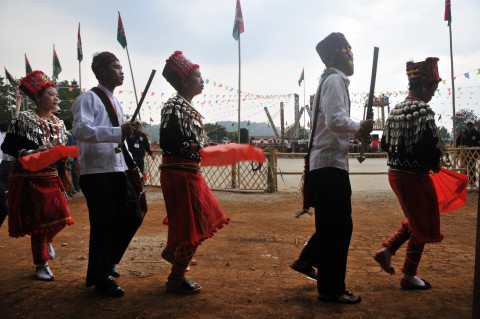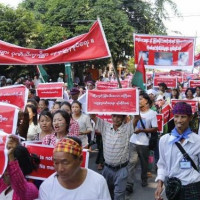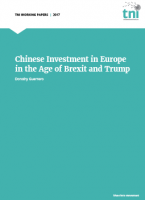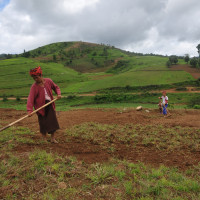ကခ်င္တိုင္းရင္းသားမ်ား သတိထားရမည့္ တ႐ုတ္ပိုးလမ္းမသစ္ စီမံကိန္း ေဒၚလဖိုင္ဆိုင္းေရာ္မွ တင္ျပေဆြးေႏြးသည္
Topics
- Land Policy in Myanmar
- Myanmar Commentary
- Ethnic Conflict in Myanmar
တ႐ုတ္-ျမန္မာ စီးပြားေရးစႀကၤန္ (China Myanmar Economic Corridor, CMEC) တည္ေဆာက္ေရး နားလည္မႈ စာခၽြန္လႊာကို ၂၀၁၈၊ စက္တင္ဘာလမွာ ျမန္မာအစိုးရႏွင့္ တ႐ုတ္အစိုးရတို႔ လက္မွတ္ေရးထိုးခဲ့သည္။ CMEC သည္ တ႐ုတ္အင္ပါယာႏွင့္ အေနာက္တိုင္း ေစ်းကြက္မ်ားကို တခ်ိန္က ခ်ိတ္ဆက္ ေပးခဲ ့သည့္ ေရွးေဟာင္းပိုးလမ္း မႀကီးကိုႏွစ္ဆယ့္တစ္ရာစုအသြင္ ျပန္လည္ ပုံေဖာ္မည့္ တ႐ုတ္ပိုးလမ္းမသစ္ စီမံကိန္း (Belt and Road Initiative, BRI) ၏ အစိတ္အပိုင္းတစ္ခု ျဖစ္သည္။

Tom Kramer
BRI မွာ “ေဒသတြင္းခ်ိတ္ဆက္မႈ ပိုမိုအားေကာင္းေစရန္ႏွင့္ ပိုမိုေတာက္ပေသာ အနာဂတ္ကို ပိုင္ဆိုင္နိုင္ေစရန္” ဟု တ႐ုတ္အစိုးရက ေျပာေသာ္လည္း တ႐ုတ္အစိုးရ၏ ကမၻာႀကီးအေပၚ လက္ဝါးႀကီးအုပ္လိုမႈကို မေပၚ႐ုံတမယ္ ဖုံးထားေသာ ကိုလိုနီလက္သစ္ဝါဒ ဟု ျမင္သူမ်ားလည္း ရွိသည္။ မူလအမည္ One Belt, One Road စီမံကိန္းမွ One ကို ျဖဳတ္ၿပီး Belt and Road Initiative, BRI အျဖစ္ အမည္ေျပာင္းလိုက္ျခင္းကိုက ဤစီမံကိန္းကို အဆိုးျမင္မႈမ်ား ေလ်ာ့ပါးသြားေအာင္ ႀကိဳးစားမႈတစ္ခုဟု ျမင္ၾကသည္။
CMEC ကို ျမန္မာနိုင္ငံတြင္ ၂၀၂၀ မတိုင္ခင္ အေကာင္အထည္ေဖာ္မည္ဟု အစိုးရအသိုင္းအဝိုင္းက ခန႔္မွန္းၾကသည္။ ၿငိမ္းခ်မ္းေရးလုပ္ငန္းစဥ္မွာ ေသာင္မတင္ေရမက်ျဖစ္ေနၿပီး တိုင္းရင္းသားေဒသမ်ားတြင္ လက္နက္ကိုင္ပဋိပကၡမ်ား ထူေျပာေနဆဲျဖစ္ေသာေၾကာင့္ ထိုေဒသမ်ားတြင္ CMEC ကို တစ္ႏွစ္အတြင္း အေကာင္အထည္ေဖာ္မည္ ဆိုသည္မွာ အခ်ိန္ေကာင္းမဟုတ္ဟု အေပၚယံအားျဖင့္ ယူဆနိုင္သည္။ သို႔ေသာ္လည္း ဒီဇင္ဘာ ၂၁ ရက္ေန႔တြင္ CMEC၏ အဓိကစီမံကိန္းေဒသမ်ားပါဝင္ေသာ စစ္ဌာနခ်ဳပ္နယ္ေျမမ်ားတြင္ တဖက္သတ္ အပစ္အခတ္ ရပ္စဲေၾကာင္း တပ္မေတာ္က ေၾကညာခဲ့သည္။ ထိုသို႔ ေၾကညာျခင္းမွာ ဤစီမံကိန္းကို တ႐ုတ္က မျဖစ္ျဖစ္ေအာင္အေကာင္အထည္ေဖာ္မည္ ျဖစ္ေၾကာင္း ျပယုဂ္တစ္ခု ျဖစ္သည္။
အပစ္အခတ္ရပ္စဲျခင္းအေၾကာင့္ လုံျခဳံေရးအေျခအေန တိုးတက္ေကာင္း တိုးတက္လာနိုင္သည္။ သို႔ေသာ္လည္း စီမံခ်က္ေဒသမ်ားရွိ တိုင္းရင္းသားေရး၊ ဘာသာေရးႏွင့္ လူမႈေရးကြာဟခ်က္မ်ားကို လ်စ္လ်ဴရႈၿပီး ခ်ိတ္ဆက္မႈကို အလ်င္စလို ခ်ဲ႕ထြင္ျခင္းမွာ လက္ရွိပဋိပကၡမ်ားကို ပိုမိုဆိုးရြားလာေစနိုင္သည္။ အထူးသျဖင့္ ကခ်င္ျပည္နယ္ႏွင့္ ရွမ္းျပည္နယ္ေျမာက္ပိုင္းလို အလြန္အထိအရွလြယ္ေသ ာေဒသ
မ်ားတြင္ တိုင္းရင္းသား ပဋိပကၡမ်ား ပိုမိုးဆိုးရြားလာေစနိုင္သည္။
အမ်ိဳးသားအဆင့္ စီမံခ်က္မ်ား အေကာင္အထည္မေဖာ္ခင္ အရင္းအျမစ္မ်ား မၽွေဝျခင္းႏွင့္ လူမႈေရးႏွင့္ ပတ္ဝန္းက်င္ အက်ိဳးသက္ေရာက္မႈမ်ားကို ေလ့လာသုံးသပ္ဖို႔ ပြင့္လင္းျမင္သာေသာ လုပ္ထုံးလုပ္နည္းတစ္ခုကို ဦးစြာအေကာင္အထည္ေဖာ္ရန္ လိုအပ္သည္။ ထိုသို႔ မလုပ္ေဆာင္လၽွင္ တ႐ုတ္ရင္းႏွီးျမဳပ္ႏွံေသာ
စီးပြားေရးလုပ္ငန္းမ်ားတြင္ ယုံၾကည္မႈ ပိုမိုနည္းပါးလာမည္။ တ႐ုတ္အစိုးရအေနႏွင့္လည္း ၿငိမ္းခ်မ္းလုပ္ငန္းစဥ္တြင္ ဘက္လိုက္မႈကင္းေသာ ေစ့စပ္ညႇိႏွိုင္းေပးသူဆိုသည့္ လူအမ်ား၏ လက္ခံယုံၾကည္မႈကို ဆုံးရႈံးရလိမ့္မည္။ ၂၀၁၁ခုႏွစ္တြင္ ျပည္သူ၏ဖိအားေပးမႈအေၾကာင့္ ရပ္ဆိုင္းခဲ့ရေသာ တ႐ုတ္ေငြျဖင့္ တည္ေဆာက္ခဲ့သည့္ မီဂါဝပ္ျမစ္ဆုံေရကာတာစီမံကိန္းကို ျပန္ၾကည့္ၿပီး သင္ခန္းစာယူနိုင္သည္။
ရပ္ရြာလူထု၏ သေဘာထားမပါဘဲ ေဖာ္ေဆာင္ခဲ့ေသာေၾကာင့္ CMEC စီမံကိန္းမွာ စိုးရိမ္စရာ ျဖစ္သည္။ တ႐ုတ္ျပည္တြင္းတြင္ BRI ကို အားျမႇင့္ေပးနိုင္မည့္ လုပ္ငန္းစီမံခ်က္မ်ား အပါအဝင္ Belt and Road တြင္ အရပ္ဖက္အဖြဲ႕အစည္းမ်ား ပါဝင္နိုင္ရန္ အခြင့္အေရးမ်ားကို တ႐ုတ္အစိုးရက ဖန္တီးေပးခဲ့သည္။ သို႔ေသာ္လည္း ဤကဲ့သို႔ အခြင့္အေရးေပးမႈမ်ိဳးကို BRI တြင္ ပါဝင္ေသာ တ႐ုတ္၏မိတ္ဖက္နိုင္ငံမ်ားတြင္ ခ်ဲ႕ထြင္လုပ္ေဆာင္ျခင္း မရွိေသာေၾကာင့္ ျမန္မာနိုင္ငံ၏ စီမံခ်က္ေရးဆြဲေရးလုပ္ငန္းစဥ္တြင္ အရပ္ဖက္လူ႔အဖြဲ႕အစည္း ပါဝင္မႈ မရွိသေလာက္ ျဖစ္သည္။
ျမန္မာနိုင္ငံရွိ တိုင္းရင္းသားထိန္းခ်ဳပ္ေသာ ေဒသမ်ားတြင္ စီမံကိန္းမ်ားကို ေဒသခံ တိုင္းရင္းသားမ်ားႏွင့္ ညႇိႏွိုင္းျခင္းမရွိဘဲ တ႐ုတ္အစိုးရႏွင့္ အမ်ိဳးသားဒီမိုကေရစီအဖြဲ႕ခ်ဳပ္ (NLD) အစိုးရၾကား သေဘာတူညီမႈႏွင့္သာ အလ်င္စလို အေကာင္အထည္ ေဖာ္လ်က္ရွိသည္။ ဥပမာ ကခ်င္ျပည္နယ္ႏွင့္ မႏၲေလးေဒသတြင္ အေကာင္အထည္ေဖာ္မည့္ စီမံကိန္းမ်ားကို CMEC ႏွင့္ဆက္ႏြယ္သည္ဟု ေၾကာ္ျငာထားေသာ္လည္း CMEC ေဘာင္တြင္ ထိုစီမံကိန္းမ်ား မည္ကဲ့သို႔ ဝင္ဆံ့သည္ကို ေဒသခံရပ္ရြာလူ႔အဖြဲ႕အစည္းမ်ား လုံးဝမသိၾကေပ။
မုန္းတိုင္းထန္ေတာ့မည္မွာ ေသခ်ာသည္။ မေျဖရွင္းရေသးသည့္ နိုင္ငံေရးနစ္နာခ်က္မ်ား၊ ပတ္ဝန္းက်င္ဆိုင္ရာ ပ်က္သုဥ္းမႈ စသည့္ နိုင္ငံေရးမုန္တိုင္းဒဏ္ခံေနရေသာ ကၽြန္မတို႔အေပၚတြင္ CMEC သည္ တိမ္စိုင္မည္းႀကီးတစ္ခုကဲ့သို႔ အုပ္မိုးထားသည္။ ကၽြန္မတို႔ ကခ်င္လူမ်ိဳးေတြ အတြက္ေတာ့ CMEC အေကာင္အထည္ေဖာ္သည္ႏွင့္ ႀကိဳက္သည္ျဖစ္ေစ၊ မႀကိဳက္သည္ျဖစ္ေစ CMEC ႏွင့္ ေနာက္ဆက္တြဲရလဒ္မ်ားကို ရင္ဆိုင္ရေတာ့မည္။
အခုအေျခအေနအရ ကၽြန္မတို႔သည္ ေရွ႕တိုး ထမ္းပိုး၊ ေနာက္ဆုတ္ လွည္းတုတ္ ဆိုသလို ေရြးခ်ယ္စရာသိပ္မရွိ။ ျမန္မာအုပ္ခ်ဳပ္မႈေအာက္က အသြင္ေျပာင္းမႈလုပ္ငန္းစဥ္ႏွင့္ ညႇိႏွိုင္းလို႔မရေသာ၊ ဗဟိုဆန္ေသာ “ၿငိမ္းခ်မ္းေရးလုပ္ငန္းစဥ္” တြင္ ပူးေပါင္းပါဝင္မည့္အစား တ႐ုတ္ႏွင့္ BRI ကို လက္တြဲရေတာ့မလား ဆိုတာ လက္ရွိ ကၽြန္မတို႔ ရင္ဆိုင္ေနရသည့္ေမးခြန္း ျဖစ္သည္။
ကၽြန္မတို႔သည္ လက္နက္ကိုင္ပဋိပကၡ၊ လူ႔အခြင့္အေရးခ်ိဳးေဖာက္ခံရမႈ၊ စစ္ေရးအရ အၾကမ္းဖက္မႈ၊ ေရႊ႕ေျပာင္းခံရမႈ၊ ဆင္းရဲမႈ၊ လူကုန္ကူးခံရမႈ၊ အပစ္အခတ္ရပ္စဲမႈ ႏွင့္ ျပန္လည္ေနရာခ်ထားျခင္းခံရမႈ ဒုကၡသံသရာထဲ ႏွစ္ေပါင္း ၇၀ က်င္လည္ခဲ့ၾကရၿပီး ဘယ္သူမွ မသိလိုက္ခင္မွာပင္ သံသရာဟာ တစ္ပတ္ျပန္လည္ေတာ့မည္။ စစ္အင္အား အလုံးအရင္းျဖင့္ တစိမ့္စိမ့္သိမ္းပိုက္ခံရေသာေခတ္ကို ျဖတ္သန္းၿပီးေနာက္ သူ႔နည္း သူ႔ဟန္နွင့္ ေၾကာက္စရာေကာင္းေသာ တ႐ုတ္က်ဴးေက်ာ္မႈေခတ္ကို ျဖတ္သန္းရဦးမည္။ ထမ္းပိုးလား၊ လွည္းတုတ္လား ေရြးစရာမရွိသည့္ ကၽြန္မတို႔ ႏွစ္ခုစလုံးကို ရင္ဆိုင္ရ ေတာ့မည္။
ဒီမုန္တိုင္းကို ကၽြန္မတို႔ ေက်ာ္ျဖတ္နိုင္ဖို႔ မုန္တိုင္း၏အားအနည္းဆုံးေနရာျဖစ္သည့္ ဗဟိုခ်က္ကို စီးနင္းထြက္ရမည္ဟု ကခ်င္အရပ္ဖက္အဖြဲ႕အစည္းႏွင့္ စီးပြားေရးလုပ္ငန္းရွင္ ဦးေဆာင္သူတခ်ိဳ႕က ယုံၾကည္သည္။ ကခ်င္လူမ်ိဳးမ်ားသည္ လူမ်ိဳးစုတစ္စုအေနျဖင့္ လူဦးေရလည္း မေျပာပေလာက္သည့္အျပင္ အားနည္းေနသည္။ ထို႔ေၾကာင့္ အမ်ားႏွင့္မဟာမိတ္ဖြဲ႕ေသာ ေပၚလစီ (multi-alligned policy) ကို က်င့္သုံးလၽွင္ ပိုအက်ိဳးရွိလိမ့္မည္၊ ထိပ္တိုက္ရင္ဆိုင္ျခင္းကို ေရွာင္ၿပီး သဟဇာတျဖစ္သည့္ လူ႔ေဘာင္ကို တည္ေထာင္ျခင္း၊ ပါဝင္ပတ္သတ္ေနသူအားလုံး အက်ိဳးရွိေစမည့္ နည္းလမ္းမ်ားကို ရွာ၍ ျမန္မာအစိုးရကိုေရာ တ႐ုတ္အစိုးရကိုပါ ဂ႐ုတစိုက္ဆက္ဆံလၽွင္ ပိုအက်ိဳးရွိလိမ့္မည္။
သို႔ေသာ္ အထက္ပါအယူအဆ၏ ျပႆနာမွာ နဂိုတည္းကမွ ကၽြန္မတို႔ကို လူရာမသြင္းေသာ ျမန္မာအစိုးရႏွင့္ တ႐ုတ္အစိုးရ ပူးေပါင္းႀကံစည္ထားေသာ လုပ္ငန္းစဥ္ထဲတြင္ ကၽြန္မတို႔ကိုယ္ကၽြန္မတို႔ ဘယ္လို ထည့္သြင္းမလဲ ဆိုသည့္ ေမးခြန္း ျဖစ္သည္။ ယခုခ်ိန္ထိ CMEC လုပ္ငန္းစဥ္၏ ဘယ္အဆင့္၊ ဘယ္က႑မွာမွ ကၽြန္မတို႔၏ အႀကံဉာဏ္ႏွင့္ ပါဝင္မႈကို ေတာင္းဆိုျခင္းမရွိေသး။ ဒါဆိုရင္ တ႐ုတ္ “ဖြံ့ၿဖိဳးေရး” စီမံကိန္းမ်ား၏ အက်ိဳးသက္ေရာက္မႈဒဏ္ကို ခံရသည့္ မေရတြက္နိုင္ေသာ ရပ္ရြာလူ႔အဖြဲ႕အစည္းမ်ား၏ ကံၾကမၼာမ်ိဳးကေန လြတ္ေျမာက္ေအာင္၊ ေစ်းႏွိမ္မခံရေအာင္ ကၽြန္မတို႔ ဘာေတြလုပ္ၾကမလဲ။
ေဒၚလာ ဘီလီယံေပါင္းမ်ားစြာ ရင္းႏွီးျမႇပ္ႏွံထားေသာ ေက်ာက္ျဖဴအထူးစီးပြားေရးဇုန္ (မေဒးကၽြန္းနားက ေရနက္ဆိပ္ကမ္းႏွင့္ ေက်ာက္ျဖဴ သဘာဝဓာတ္ေငြ႕ပိုက္လိုင္း) မွာထင္ရွားသည့္ ဥပမာ တစ္ခု ျဖစ္သည္။ ပိုမိုေတာက္ပေသာ အနာဂတ္၊ ပိုမိုေကာင္းမြန္ေသာ အလုပ္အကိုင္အခြင့္အေရးမ်ားကို ေမၽွာ္လင့္ခဲ့ေသာ ေဒသခံလူထု၏အိပ္မက္မ်ား ပ်က္စီးရသည့္အျပင္ ေျမယာအမ်ားအျပား သိမ္းပိုက္ ခံရျခင္းမ်ား၊ ေဒသတြင္း ငါးဖမ္းလုပ္ငန္းခြင္မ်ား ပ်က္စီးျခင္း၊ တရားမဝင္ ေျမယာသိမ္းပိုက္ခံရမႈအတြက္ ဆန႔္က်င္ဆႏၵျပျခင္းေၾကာင့္ အဖမ္းခံရျခင္း၊ ေထာင္ခ်ခံရျခင္းမ်ားႏွင့္သာ ရင္ဆိုင္ခဲ့ ၾကရသည္။ ထိုသို႔ ထိန္းမနိုင္သိမ္းမရျဖစ္ေနေသာ အေျခအေနမ်ားေၾကာင့္ ရခိုင္န ိုင္ငံေရးပါတီမ်ားႏွင့္ လူမႈအဖြဲ႕အစည္းမ်ားမွာ ေဒသခံရခိုင္လူထုကို တိုင္ပင္ျခင္းမျပဳဘဲ BRI ႏွင့္ဆက္စပ္ေသာ စီမံကိန္းႀကီးမ်ားကို ဆက္မလုပ္ဖို႔ ေတာင္းဆိုေနၾကပါၿပီ။
တ႐ုတ္ပညာရွင္ ယြမ္ယြမ္အန္းက “BRI ဟာ လမ္းျပေျမပုံ လိုတယ္၊ BRI ဟာ တ႐ုတ္ကြန္ျမဴနစ္ပါတီရဲ့ တျခားစီမံကိန္းေတြလိုပဲ သိပ္ႀကီးမားၿပီး အခ်ိတ္အဆက္မမိ ျဖစ္ေနတယ္” ဟု ေျပာသည္။ “BRI ဟာ (တ႐ုတ္အစိုးရက ျဖစ္ေစခ်င္သည့္) ေမၽွာ္မွန္းခ်က္တစ္ခုသာျဖစ္ၿပီး စီမံခ်က္တစ္ခု မဟုတ္ဘူး” ဟုလည္း သူမက ထပ္ျဖည့္ေျပာသည္။ ကၽြန္မအတြက္ေတာ့ ေမၽွာ္မွန္းခ်က္ဆိုသည္မွာ ဗိုလ္ခ်ဳပ္ေအာင္ဆန္း၏ ျပည္ေထာင္စုျမန္မာနိုင္ငံအတြက္ ေမၽွာ္မွန္းခ်က္ဆိုသည္ႏွင့္ ခပ္ဆင္ဆင္တူေနသည္မွာ ရင္ထိပ္စရာေကာင္းသည္။ ပင္လုံစာခ်ဳပ္ဆိုသည္မွာ မတူကြဲျပားေသာ တိုင္းရင္းသားလူမ်ိဳးမ်ားစြာ အတူတကြ ေနထိုင္ နိုင္သည့္ ျပည္ေထာင္စုႀကီးတစ္ခု ေဖာ္ေဆာင္ဖို႔အတြက္ လက္ေတြ႕က်ေသာ စီမံခ်က္မဟုတ္ဘဲ ၿဗိတိသၽွအစိုးရဆီက ျမန္ျမန္ဆန္ဆန္ႏွင့္ လြယ္လြယ္ကူကူ လြတ္လပ္ေရးရရွိရန္ တက္သုတ္ရိုက္ ဖန္တီးထားေသာ ကိရိယာတစ္ခုသာ ျဖစ္သည္။ အက်ိဳးဆက္မွာ လြတ္လပ္ေရးရၿပီး အႏွစ္ ၇၀ ၾကာၿပီးခ်ိန္တြင္ ဗမာလူမ်ိဳးမဟုတ္သည့္ တိုင္းရင္းသားမ်ားက ဗမာလူမ်ိဳးမ်ားဟာ အရင္တုန္းကေရာ အခုေရာ ဘယ္တုန္းကမွ တိုင္းရင္းသားမ်ားႏွင့္ ျပည္ေထာင္စုဖြဲ႕ေနခ်င္တာ မဟုတ္ဘူးလို႔ ယုံၾကည္လက္ခံ လာျခင္း ျဖစ္သည္။
CMEC လုပ္ငန္းေကာ္မတီတစ္ခုလုံးကို ၾကည့္မယ္ဆိုလၽွင္ ဗမာကလြဲလို႔ တျခား တိုင္းရင္းသားမ်ားပါဝင္သည္ကို မေတြ႕ရပါ။ ေကာ္မတီမွာ ဘယ္သူေတြပါသလဲ မေၾကညာေသးေပမည့္ ေကာ္မတီတြင္ ပါဝင္ေသာ အဖြဲ႕အစည္းမ်ားမွာ တပ္မေတာ္ႏွင့္ NLD ၏ အက်ိဳးစီးပြားကို ကိုယ္စားျပဳေသာ အဖြဲ႕အစည္းမ်ားသာ ျဖစ္လိမ့္မည္ဟု ယူဆၾကသည္။ CMEC စီမံခ်က္ေရးဆြဲသူမ်ားအေနႏွင့္ အာဏာရပါတီႏွင့္ စစ္တပ္ကိုသာ ညႇိႏွိုင္းၿပီး ရင္းႏွီးျမႇပ္ႏွံမႈ စီမံကိန္းမ်ား ေဖာ္ေဆာင္ျခင္း၏ ဆိုးရြားေသာ အက်ိဳးသက္ေရာက္မႈမ်ားကို ျပန္လည္ သုံးသပ္သင့္သည္။
ယခုအခ်ိန္တြင္ ကၽြန္မတို႔၏ နိုင္ငံမွာ ခိုင္မာတည္တံ့ေသာ အေျပာင္းအလဲမ်ား ျဖစ္ဖို႔ ဝိုင္းၿပီးႀကိဳးပမ္းေနၾကသူ အားလုံး၏စည္းလုံးမႈသာ အေရးႀကီးဆုံး ျဖစ္သည္။ CMEC ႏွင့္ ပတ္သတ္ေသာ ညႇိႏွိုင္းေဆြးေႏြးပြဲမ်ားတြင္ တ႐ုတ္ႏွင့္ NLD အစိုးရ ကိုယ္စားလွယ္မ်ား ႏွင့္အတူ တိုင္းရင္းသား လက္နက္ကိုင္ အဖြဲ႕အစည္းမ်ား၊ နိုင္ငံေရးပါတီမ်ား၊ အရပ္ဖက္လူမႈအဖြဲ႕အစည္းမ်ားက ကိုယ္စားလွယ္မ်ားပါ ပါဝင္သင့္သည္။ ကၽြန္မတို႔ နိုင္ငံေတာ္၏ လြတ္လပ္ေရးကို ထိန္းသိမ္းခ်င္သည္ဆိုလၽွင္ ဤစိန္ေခၚမႈႀကီး၏ဗဟိုခ်က္ကို ဆြဲကိုင္ၿပီး ျဖတ္သန္းဖို႔လိုသည္။ ဒါဟာ ကၽြန္မတို႔အားလုံးအတြက္ စိန္ေခၚမႈပဲ ျဖစ္သည္။
အလားတူပင္ တိုင္းရင္းသား လက္နက္ကိုင္ အဖြဲ႕အစည္းမ်ား၊ နိုင္ငံေရးပါတီမ်ား၊ အရပ္ဖက္လူမႈအဖြဲ႕အစည္းမ်ားသည္ ၿငိမ္းခ်မ္းေရးလုပ္ငန္းစဥ္မွာလည္း ဖက္ဒရယ္ေဘာင္အတြင္းမွာ ပူးေပါင္းေဆာင္ရြက္နိုင္ေသာ အရည္အခ်င္းရွိသည္၊ လူမ်ားစုဗမာတိုင္းရင္းသားမ်ားႏွင့္ လက္တြဲလုပ္ေဆာင္နိုင္သည္ကို သက္ေသျပဖို႔ လိုသည္။ ဤအေျခအေနကေန ကၽြန္မတို႔ မ႐ုန္းထြက္နိုင္လၽွင္ တ႐ုတ္နိုင္ငံ ရွင္းက်န္း (Xinjiang) ျပည္နယ္မွ အြီးဂါး (Uighur) လူမ်ိဳးေတြလိုပင္ ကၽြန္မတို႔သည္လည္း ကိုယ့္ျပည္နယ္မွာကိုယ္ အသိအမွတ္ျပဳမခံရေသာ လူမ်ိဳးမ်ား ျဖစ္သြားပါလိမ့္မည္၊ တိုင္းရင္းသားလက္နက္ကိုင္ အဖြဲ႕အစည္းမ်ားကို ခြဲထြက္ေရးဝါဒီ၊ အၾကမ္းဖက္ဝါဒီမ်ားဟု စြပ္စြဲၿပီး ျမန္မာစစ္တပ္၏ တိုက္ခိုက္မႈမ်ားကို ဆက္လက္ ေတြ႕ၾကဳံေနရဦးမည္။
အုပ္ခ်ဳပ္ေနေသာ ဗမာအထက္လႊာကလည္း တိုင္းရင္းသားလက္နက္ကိုင္ အဖြဲ႕အစည္းမ်ားကို (အစိုးရကို ျဖဳတ္ခ်လိုသူမ်ားႏွင့္ ရန္သူမ်ားဟု အဓိပၸာယ္ရသည့္) “သူပုန္မ်ား” ဟု မသတ္မွတ္ဘဲ တည္ၿငိမ္ၿပီး ကုန္ထုတ္စြမ္းအားေကာင္းေသာ နိုင္ငံေတာ္ကို ေဖာ္ေဆာင္လိုသည့္ ညီအစ္ကိုေမာင္ႏွမမ်ားဟု နားလည္လက္ခံထားရန္ လိုအပ္သည္။
ျမန္မာျပည္ ၿငိမ္းခ်မ္းေရးကို လိုလားသည့္အျပင္ နိုင္ငံတစ္ခု မူဝါဒ ႏွစ္ခု၊ သုံးခု (ေဟာင္ေကာင္၊ မကာအို) အေတြ႕အႀကဳံရွိေသာ ဧရာမအိမ္နီးခ်င္း တ႐ုတ္နိုင္ငံသည္လည္း ကၽြန္မတို႔ကို အမ်ားႀကီး အကူအညီေပးနိုင္သည္။ သဘာဝအရင္းအျမစ္မ်ားကို မၽွေဝသုံးစြဲျခင္း၊ ကိုယ့္ၾကမၼာကိုယ္ ဖန္တီးနိုင္ေသာ အရည္အခ်င္းရွိျခင္း၊ အဓိကက်ေသာ နိုင္ငံေရးျပႆနာမ်ားကို ေျဖရွင္းရာတြင္ ျမန္မာအစိုးရႏွင့္ ရင္ေဘာင္တန္းေဆြးေႏြးနိုင္ေသာ အေျခအေနကို ဖန္တီးနိုင္ျခင္း ဆိုသည့္ က႑မ်ားတြင္ ေရရွည္ထိန္းသိမ္းနိုင္မည့္ ေထာက္ပံ့မႈမ်ားကို တ႐ုတ္က ေပးနိုင္သည္။ တစ္နိုင္ငံလုံး ပစ္ခတ္တိုက္ခိုက္မႈ ရပ္စဲေရး သေဘာတူစာခ်ဳပ္ လုပ္ငန္းစဥ္ႏွင့္ ဒီမိုကေရစီ ျပ ဳျပင္ ေျပာင္းလဲမႈမ်ား ၂၀၂၀ တြင္ လမ္းေၾကာင္းေပၚျပန္ေရာက္လာလၽွင္ ကၽြန္မတို႔၏အိပ္မက္မ်ား အေကာင္အထည္ ေပၚလာၿပီဟုပင္ ဆိုနိုင္သည္။
ဤအဆင့္မ်ားကို မလုပ္ေဆာင္လၽွင္ ျမန္မာနိုင္ငံတြင္ တ႐ုတ္၏စီးပြားေရးစီမံကိန္းသည္ မေအာင္ျမင္သည့္အျပင္ ျမန္မာနိုင္ငံသည္လည္း ဒီမိုကေရစီႏွင့္ လိုက္ေလေဝးေလ ျဖစ္ေနၿပီး ျပည္ေထာင္စုစိတ္ဓာတ္သည္လည္း ျပန္လည္ရွင္သန္နိုင္မည္ မဟုတ္ေတာ့ေပ။
“ျမန္မာ/ဗမာ” ဆိုသည္မွာ ျမန္မာနိုင္ငံရွိ လူမ်ားစုတိုင္းရင္းသားအုပ္စု၏အမည္ ျဖစ္သည္။ ထို႔ေၾကာင့္ “ျမန္မာ” သည္ တိုင္းရင္းသားလူမ်ိဳးစုတစ္စုကိုသာ ကိုယ္စားျပဳၿပီး အျခားတိုင္းရင္းသားမ်ားကို ကိုယ္စားမျပဳ။ ျမန္မာ/ဗမာ မဟုတ္ေသာ တိုင္းရင္းသားလူမ်ိဳးစုမ်ားသည္ ၿဗိတိသၽွထံမွ လြတ္လပ္ေရးရရွိရန္ လူမ်ားစုျဖစ္ေသာ ျမန္မာ/ဗမာ တို႔ႏွင့္ ပူးေပါင္း၍ ျပည္ေထာင္စုတစ္ခု တည္ေထာင္ရန္ ဆုံးျဖတ္ခဲ့ၾကသည္။ ၁၉၄၇ ပင္လုံစာခ်ဳပ္အရ ျပည္ေထာင္စုကို တည္ေထာင္ခဲ့ၿပီး ထိုစာခ်ဳပ္မွာ တိုင္းရင္းသားလူနည္းစုအားလုံးကို ျပည္ေထာင္စုတည္ေထာင္သူမ်ား အျဖစ္ (ျမန္မာ/ဗမာမ်ားႏွင့္) တန္းတူအခြင့္အေရးေပးခဲ့သည္။ ပင္လုံသဘာတူညီခ်က္မ်ားကို အေကာင္အထည္မေဖာ္နိုင္ျခင္းမွအစျပဳၿပီး ျမန္မာ/ဗမာ၏ အုပ္ခ်ဳပ္မႈကို လူနည္းစု တိုင္းရင္းသားမ်ား လက္မခံခဲ့ၾကျခင္း ျဖစ္သည္။
လဖိုင္ဆိုင္းေရာ္သည္ ၂၀၁၃ ခုႏွစ္ ေရမြန္မက္ေဆးေဆးဆုရွင္ ျဖစ္ၿပီး ေမတၱာဖြံ႔ၿဖိဳးေရးေဖာင္ေဒးရွင္းႏွင့္ ဧရာဝတီေဖာင္ေဒးရွင္းတို႔ကို ထူေထာင္သူျဖစ္သည္။ သူမသည္ ၂၁ ရာစု ပင္လုံညီလာခံကို တက္ေရာက္သူ ကိုယ္စားလွယ္ တစ္ဦးလည္း ျဖစ္သည္။ ဤေဆာင္းပါးကို Kachinland News တြင္ စတင္ေဖာ္ျပခဲ့သည္။



